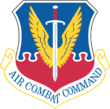16th Airborne Command and Control Squadron
| 16th Airborne Command and Control Squadron | |
|---|---|
|
E-8C Joint STARS aircraft of the 461st Air Control Wing | |
| Active | 1943-1949; 1950-1989; 1996-present |
| Country |
|
| Branch |
|
| Role | Airborne Command and Control |
| Part of | Air Combat Command |
| Garrison/HQ | Robins Air Force Base, Georgia |
| Motto | Light the Way |
| Insignia | |
| 16th Airborne Command and Control Squadron emblem |
 |


The 16th Airborne Command and Control Squadron (ACCS) is a unit of Air Combat Command of the United States Air Force, and flies the E-8C Joint STARS. Its parent unit is the 461st Air Control Wing, located at Robins Air Force Base, Georgia.
Overview
The 16 ACCS operates the E-8C Joint Surveillance Target Attack Radar System (J-STARS), an advanced ground surveillance and battle management system. J-STARS detects, locates, classifies, tracks and targets ground movements on the battlefield, communicating real-time information through secure data links with combat command posts.
History
World War II
The squadron was first activated as the 380th Fighter Squadron, part of IV Fighter Command in early 1943. It engaged in the air defense of the San Francisco area as well as acting as a Replacement Training Unit until the end of 1943. It trained as a North American P-51 Mustang operational squadron before deploying to the European Theater of Operations. In Europe it became part of IX Fighter Command in England. Operated both as a tactical fighter squadron, providing air support to Allied ground forces in France as well as an air defense squadron, attacking enemy aircraft in air-to-air combat over Europe.
The squadron was converted to a tactical reconnaissance squadron in August 1944, when it was redesignated the 160th Tactical Reconnaissance Squadron. It engaged in hazardous reconnaissance flights over enemy-controlled territory unarmed, gathering intelligence for Allied commanders until the end of combat in Europe, May 1945. The unit advanced eastward across France using advanced landing grounds, then into the Low Countries and Occupied Germany.
The squadron remained in Germany as part of the occupation forces, returning to Langley Field, Virginia in June 1947. The unit remained assigned to Tactical Air Command as a reconnaissance squadron. The squadron was inactivated in 1949.
Cold War
In 1950 the squadron was activated once again at Langley, now designated the 16th Tactical Reconnaissance Squadron. It moved to Shaw Air Force Base, South Carolina in 1958 where it re-equipped with McDonnell RF-101C Voodoo reconnaissance aircraft. The squadron deployed to south Florida in 1962 during the Cuban Missile Crisis, flying hazardous overflights over Cuba gathering intelligence photos. The unit upgraded to the McDonnell Douglas RF-4C Phantom II in 1965. It also operated a flight of Martin EB-57E Canberra electronic warfare aircraft. It added Douglas EB-66 Destroyer jamming aircraft beginning in 1971 as part of the phaseout of the Destroyer at Shaw. It was the last USAF active duty B-57 squadron, retiring the aircraft in 1976 when F-4G Phantom IIs took over its mission.
The 16th remained the single RF-4C squadron at Shaw after the 1982 realignment of its parent 363d from a tactical reconnaissance to tactical fighter wing. It continued reconnaissance training in the United States until 1989 when the RF-4Cs were transferred to 67th Tactical Reconnaissance Wing at Bergstrom Air Force Base, Texas, and the squadron was inactivated.
Joint Surveillance Target Attack Radar System
The squadron was reactivated as the 16th Airborne Command and Control Squadron in 1996 at Robins Air Force Base, GA as an E-8 JSTARS squadron.
Lineage
- Constituted as the 380th Fighter Squadron (Single Engine) on 11 February 1943
- Activated on March 1943
- Redesignated 160th Tactical Reconnaissance Squadron on 25 August 1944
- Redesignated 160th Reconnaissance Squadron, Photographic on 29 Ju1y 1946
- Redesignated 160th Tactical Reconnaissance Squadron, Photographic on 14 June 1948
- Inactivated on 26 April 1949
- Redesignated 160th Tactical Reconnaissance Squadron, Night Photographic on 8 August 1950
- Activated on 1 September 1950
- Redesignated 16th Tactical Reconnaissance Squadron, Night Photographic on 10 October 1950
- Redesignated 16th Tactical Reconnaissance Squadron, Night Photographic-Jet on 8 November 1955
- Redesignated 16th Tactical Reconnaissance Squadron, Photographic-Jet on 1 March 1965
- Redesignated 16th Tactical Reconnaissance Squadron on 8 October 1966
- Redesignated 16th Tactical Reconnaissance Training Squadron on 1 October 1979
- Redesignated 16th Tactical Reconnaissance Squadron on 1 July 1982
- Inactivated on 15 December 1989
- Redesignated 16th Airborne Command and Control Squadron on 15 January 1996
- Activated on 1 October 1996
- Allotted to the Air National Guard on 1 October 2002 (remained active)
- Withdrawn from the Air National Guard on 1 October 2012 (remained active)
Assignments
- 363d Fighter (later Tactical Reconnaissance) Group, 1 March 1943
- Air echelon attached to 10th Photographic Group, 24 December 1944-6 February 1945
- 10th Reconnaissance Group, 15 November 1945
- Tactical Air Command, 25 June 1947
- 363d Reconnaissance Group (later Tactical Reconnaissance Group), 24 July 1947 - 26 April 1949
- 363d Tactical Reconnaissance Group, 1 September 1950
- 363d Tactical Reconnaissance (later Tactical Fighter) Wing, 8 February 1958 - 13 December 1989
- 93d Operations Group, 1 October 1996
- 116th Operations Group, 1 October 2002
- 461st Operations Group, 1 October 2012 - present
Stations
|
|
Aircraft
|
|
References
Notes
Bibliography
![]() This article incorporates public domain material from websites or documents of the Air Force Historical Research Agency.
This article incorporates public domain material from websites or documents of the Air Force Historical Research Agency.
- Maurer, Maurer, ed. (1982) [1969]. Combat Squadrons of the Air Force, World War II (reprint ed.). Washington, DC: Office of Air Force History. ISBN 0-405-12194-6. LCCN 70605402. OCLC 72556.
- Rogers, B. (2006). United States Air Force Unit Designations Since 1978. ISBN 1-85780-197-0
- World Airpower Journal. (1992). US Air Force Air Power Directory. Aerospace Publishing: London, UK. ISBN 1-880588-01-3
External links
| |||||||||||||||||||||||||||||||||||||||||||||||
.jpg)



.svg.png)